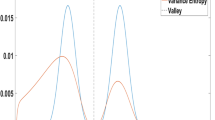Abstract
This paper presents a technique that gives a minimal window W for the estimation of a W-operator from training data. The idea is to choose a subset of variables W that maximizes the information observed in a training set. The task is formalized as a combinatorial optimization problem, where the search space is the powerset of the candidate variables and the measure to be minimized is the mean entropy of the estimated conditional probabilities. As a full exploration of the search space requires prohibitive computational effort, some heuristics of the feature selection literature are applied. The proposed technique is mathematically sound and experimental results including binary image filtering and gray-scale texture recognition show its successful performance in practice.

















Similar content being viewed by others
References
Barrera J, Terada R, Hirata R Jr, Hirata NST (2000) Automatic programming of morphological machines by pac learning. Fundamenta Informaticae, pp 229–258
Di Ruberto C, Dempster A, Khan S, Jarra B (2002) Analysis of infected blood cell images using morphological operators. Image Vis Comput 20(2):133–146
Dougherty ER (2004) Automatic design of morphological operators. J Electron Imaging 13(3):486–491
Green AC, Marshall S, Greenhalgh D, Dougherty ER (2003) Design of multi-mask aperture filters. Signal Processing 83(9):1961–1971
Pitas I, Venetsanopoulos AN (1990) Nonlinear digital filters. Kluwer, Dordrecht
Dougherty ER, Barrera J (2002) Pattern recognition theory in nonlinear signal processing. J Math Imaging Vis 16(3):181–197
Hirata NST, Dougherty ER, Barrera J (2000) A switching algorithm for design of optimal increasing binary filters over large windows. Pattern Recognit 33:1059–1081
Soille P (2002) On morphological operators based on rank filters. Pattern Recognit 35(2):527–535
Jain A, Zongker D (1997) Feature selection—evaluation, application, and small sample performance. IEEE Trans Pattern Anal Mach Intell 19(2):153–158
Theodoridis S, Koutroumbas K (1999) Pattern recognition, 1st edn. Academic, New York
Pudil P, Novovicová J, Kittler J (1994) Floating search methods in feature selection. Pattern Recognit Lett 15:1119–1125
Shannon CE (1948) A mathematical theory of communication. Bell Syst Tech J 27:379–423, 623–656
Cover TM, Thomas JA (1991) Elements of information theory. In: Wiley series in telecommunications. Wiley, New York
Kullback S (1968) Information theory and statistics. Dover, New York
Soofi ES (2000) Principal information theoretic approaches. J Am Stat Assoc 95:1349–1353
Duda RO, Hart PE, Stork D (2000) Pattern classification. Wiley, New York
Hall MA, Smith LA (1999) Feature selection for machine learning: comparing a correlation-based filter approach to the wrapper. In: Proceedings of the FLAIRS conference, AAAI Press, pp 235–239
Lewis DD (1992) Feature selection and feature extraction for text categorization. In: Proceedings of speech and natural language workshop, Morgan Kaufmann, San Mateo, pp 212–217
Bonnlander BV, Weigend AS (1994) Selecting input variables using mutual information and nonparametric density estimation. In: Proceedings of the 1994 international symposium on artificial neural networks, Tainan, pp 42–50
Viola P, Wells WM III (1997) Alignment by maximization of mutual information. Int J Comput Vision 24(2):137–154
Zaffalon M, Hutter M (2002) Robust feature selection by mutual information distributions. In: 18th international conference on uncertainty in artificial intelligence (UAI), pp 577–584
Costa LF, Cesar RM Jr (2001) Shape analysis and classification: theory and practice. CRC Press, Boca Raton
Dougherty ER, Kim S, Chen Y (2000) Coefficient of determination in nonlinear signal processing. Signal Processing 80:2219–2235
Vaquero DA, Barrera J, Hirata R Jr (2005) A maximum-likelihood approach for multiresolution W-operator design. In: Proceedings of XVIII Brazilian symposium on computer graphics and image processing (SIBGRAPI). IEEE Computer Society Press, pp 71–78
Acknowledgments
The authors are grateful to FAPESP (99/12765-2, 01/094 01-0, 04/03967-0 and 05/00587-5), CNPq (300722/98-2, 468 413/00-6, 521097/01-0 474596/04-4 and 491323/05-0) and CAPES for financial support. This work was partially supported by grant 1 D43 TW07015-01 from the National Institutes of Health, USA. We also thank Daniel O. Dantas by his complementing post-processing idea for texture recognition (mode filter applied more than once).
Author information
Authors and Affiliations
Corresponding author
Rights and permissions
About this article
Cite this article
Martins, D.C., Cesar, R.M. & Barrera, J. W-operator window design by minimization of mean conditional entropy. Pattern Anal Applic 9, 139–153 (2006). https://doi.org/10.1007/s10044-006-0031-0
Received:
Accepted:
Published:
Issue Date:
DOI: https://doi.org/10.1007/s10044-006-0031-0




